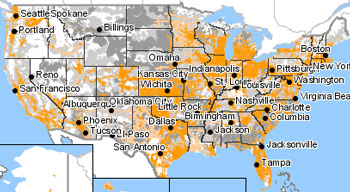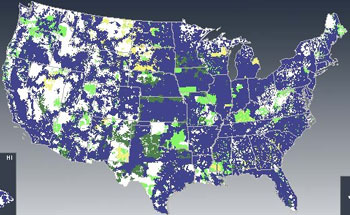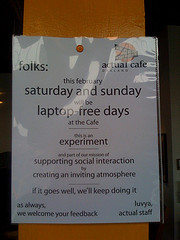I finally read the GQ piece that's been widely cited as "proving" the dangers of electromagnetic radiation produced by cell phones: It's a piece of crap. The article spends the vast majority of its time looking into corporate conspiracy to keep news about cell-radiation issues silent, and giving a forum to anecdote and studies that have since been shredded to pieces for lack of rigor.
I don't doubt that corporations have worked hard to prevent studies from coming out that would show any correlation of risk, because that's a common pattern for large corporations. That said, there's such a huge amount of data, and studies with such large cohorts, it's hard to believe that companies were successful in "suppressing" such data.
The reason I even address GQ, provider of fine investigative journalism that it is not, is that a Santa Fe resident was nearly hauled out of a city council meeting after arguing against installing more wireless base stations--perhaps for cellular. The Los Alamos National Laboratory physicist Frank Bruno is pictured in this article holding up this awful GQ story as part of his proof that microwave radiation is deadly. So it can't be ignored.
I'm going to focus on two elements in the story, because it's mostly full of farragoes and nonsense.
The first is the Interphone study, the best science cited in the article. Thousands of people with certain cancers that seem likely to result from close proximity to cell phones were selected, interviewed, and results compared against interviews with controls selected from the population at large in those countries. Despite the huge amount of effort to recruit subjects, just under 8,000 participants with cancers were interviewed (several hundred per country) and under 7,000 controls.
But studies resulting from Interphone don't say what the GQ article alleges. The author writes, "Interphone researchers reported in 2008 that after a decade of cell-phone use, the chance of getting a brain tumor—specifically on the side of the head where you use the phone—goes up as much as 40 percent for adults." That's not inaccurate, but it leaves out 100 percent of the context.
The study itself (International Journal of Cancer, Vol 120, Issue 8, 2007), which perhaps the GQ author didn't read, notes, "The results of our analyses do not provide consistent evidence for increased risk of glioma related to use of mobile phones. We did not find indications of increased risk related to regular mobile phone use overall, or in the majority of the subanalyses based on various exposure characteristics. The most exposed group (the highest 10% based on the exposure distribution among controls) did not show an elevated risk of glioma."
The study authors do not that in one subset of analysis that single-sided cell use, as reported by subjects, 10 or more years ago "was associated with significantly increased risk of glioma and there was also an increasing trend with years since first use on the ipsilateral side."
The study authors note that there's likely strong reporting bias on both use and which side a person regularly talks on. The conclusion about the higher rates: "This may be due to either chance or causal effect or information bias, i.e. overreporting of mobile phone use on the affected side by the cases with brain tumors."
The "latest update" on Interphone research--8 October 2008--citing this and other studies concludes fairly strongly that there are a few areas that should be looked at further, but that the data generally supports no pattern or revelation about a connection between cancers studied and cell phone usage patterns.
I won't go into every other item mentioned in the GQ article, because we have had discussions at this site over the years on these subjects.
What I will mention is that none of the vast array of credible information contrary to the conclusions of this author and, obviously, GQ, were mentioned except in passing. This includes the now dozens of well-conducted, published studies that find no connection between a signal and "electrosensitivity," and some of which show the presence of measurable, severe symptoms whether a signal is present or absent.
The second element simply reveals the poor knowledge of the reporter and factchecking employed by GQ. The article notes,
In the summer of 2006, a super-Wi-Fi system known as WiMAX was tested in rural Sweden. Bombarded with signals, the residents of the village of Gtene—who had no knowledge that the transmitter had come online—were overcome by headaches, difficulty breathing, and blurred vision, according to a Swedish news report. Two residents reported to the hospital with heart arrhythmias, similar to those that, more than thirty years ago, Allen Frey induced in frog hearts. This happened only hours after the system was turned on, and as soon as it was powered down, the symptoms disappeared.
So where did this come from? I'd never heard of this. And WiMax wasn't commercially available except in test form in 2006. What non-cited "Swedish news report" covered this?
I used The Google to find out. First off, it wasn't summer, it was February 2006. Second, the report seems to have originated at the Inquirer on 12 June 2006, which links to an Australian bulletin-board on ISPs, which has a post by a reader named Brains, which links to a 23 May 2006 report from Sweden's STV network.
That report, which is neither available at the original URL, nor could I find by searching on stories on Gtene (of which there are many), is paraphrased here by someone who backs the electrosensitive theory. The story apparently came from a "current affairs program 'Debatt,'" rather than from public-health officials or other sources. Nor does the Australian link mention that the system was shut down; nor can I find any evidence it was.
Following this further, I found on an anti-EMF-use site that the Debatt program is, well, a debate: two Swedish experts pro and two con as to whether EMF poses a threat to health. The usual Swedish sources (Mona Nilsson and Olle Johansson) took the view that there was a threat to health. The Gtene story was apparently a lead-in, and it's unclear whether the guest representing the Swedish government provided any refutation to the details.
The GQ author follows this up by noting, "Today, Sprint Nextel and Clearwire are set to establish similar technology across the U.S., with a $7.2 billion government broadband stimulus speeding the rollout."
Dozens of WiMax systems are up and running in the United States, and hundreds worldwide (some quite modest). The power output of WiMax is comparable to cellular, although using mostly different frequencies. The notion that WiMax is something new and different than 3G from a signal perspective or "electrosmog" view is nonsense.
The GQ article doesn't advance any knowledge in this area, lacks rigor, and again gives credence to what is palpably a false cause for those suffering from real symptoms--ones that have been repeatedly shown to be unrelated to "cell radiation."
Chaska’s Local Paper Looks at Wi-Fi Pioneer Chaska.netPaul Weller denies Jam reunion
![]()





